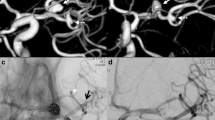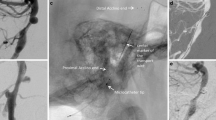Abstract
Purpose
The introduction of low-profile stent systems has broadened and facilitated the treatment of complex intracranial aneurysms. This retrospective case series study was conducted to assess and compare the clinical and angiographic outcomes of patients with complex intracranial aneurysms who were treated with ACCLINO® (AS) and ACCLINO® flex stents (AFS).
Methods
In 85 patients (female 61; male 24) a total of 95 complex intracranial aneurysms, 71 (74.7%) in the anterior circulation and 24 (25.3%) in the posterior circulation were treated. Angiographic and clinical data, aneurysm characteristics and follow-up results were analyzed.
Results
The AS was used in 47 cases (49.5%) and the AFS in 48 cases (50.5%). Initial angiography after the intervention showed a complete occlusion in 52.6% (Raymond-Roy occlusion classification [RROC] 1), a neck remnant in 38.9% (RROC 2) and an incomplete occlusion in 8.4% (RROC 3). Follow-up (AS: 25.2 ± 15.4 months; AFS: 9.6 ± 8.0 months) revealed an occlusion rate of 70.5% (RROC 1), 27.4% (RROC 2) and 2.1% (RROC 3). There was no statistically significant difference between the initial (p = 0.484) and the follow-up occlusion rate (p = 0.284) when comparing the two devices. Recoiling was performed in 8 cases (8.4%). The overall complication rate was 9.5% with 5 strokes (5.3%), 2 hemorrhages (2.1%), 1 in-stent stenosis (1.1%), 1 stent occlusion (1.1%) and 2 stent thromboses (2.1%). There was no procedure-related mortality.
Conclusion
Using the ACCLINO® and ACCLINO® flex stent system is a feasible and effective procedure with an acceptable safety profile. Initial and follow-up angiographic results were satisfactory.




Similar content being viewed by others
Abbreviations
- AFS:
-
ACCLINO® flex stent
- AS:
-
ACCLINO® stent
- LVIS:
-
Low-profile visualized intraluminal support
- MCA:
-
Middle cerebral artery
- MRI:
-
Magnetic resonance imaging
- PICA:
-
Posterior inferior cerebellar artery
- RROC:
-
Raymond-Roy occlusion classification
- SAH:
-
Subarachnoid hemorrhage
References
Bendok BR, Parkinson RJ, Hage ZA, Adel JG, Gounis MJ. The effect of vascular reconstruction device-assisted coiling on packing density, effective neck coverage, and angiographic outcome: an in vitro study. Neurosurgery. 2007;61:835–40. discussion 840–1.
Higashida RT, Smith W, Gress D, Urwin R, Dowd CF, Balousek PA, Halbach VV. Intravascular stent and endovascular coil placement for a ruptured fusiform aneurysm of the basilar artery. Case report and review of the literature. J Neurosurg. 1997;87:944–9.
Andaluz N, Zuccarello M. Treatment strategies for complex intracranial aneurysms: review of a 12-year experience at the at the University of Cincinnati. Skull Base. 2011;21:233–42.
Roy D, Milot G, Raymond J. Endovascular treatment of unruptured aneurysms. Stroke. 2001;32:1998–2004.
Kabbasch C, Liebig T, Faymonville A, Dorn F, Mpotsaris A. Initial clinical experience with a new self-expanding nitinol microstent for the treatment of wide-neck Intracranial cerebral aneurysms: the Acandis Acclino Stent. J Vasc Interv Neurol. 2015;8:1–6.
Goertz L, Smyk MA, Mpotsaris A, Borggrefe J, Dorn F, Liebig T, Schlamann M, Laukamp K, Krischek B, Turowski B, Kabbasch C. Long-term angiographic results of the low-profile acandis acclino stent for treatment of intracranial aneurysms : a multicenter study. Clin Neuroradiol. 2019 Nov 15. doi: 10.1007/s00062-019-00847-4. [Epub ahead of print]
http://www.1amedical.org/wp-content/uploads/2014/04/balt-leobaby.pdf. Accessed 23 Nov 2018
Ulfert C, Pham M, Sonnberger M, Amaya F, Trenkler J, Bendszus M, Möhlenbruch MA. The Neuroform Atlas stent to assist coil embolization of intracranial aneurysms: a multicentre experience. J Neurointerv Surg. 2018;10:1192–6.
McLaughlin N, McArthur DL, Martin NA. Use of stent-assisted coil embolization for the treatment of wide-necked aneurysms: A systematic review. Surg Neurol Int. 2013;4:43.
Tureli D, Sabet S, Senol S, Andac N, Donmez H, Geyik S, Baltacioglu F, Cekirge S. Stent-assisted coil embolization of challenging intracranial aneurysms: initial and mid-term results with low-profile ACCLINO devices. Acta Neurochir (Wien). 2016;158:1545-53.
Brassel F, Grieb D, Meila D, Schlunz-Hendann M, Greling B, Melber K. Endovascular treatment of complex intracranial aneurysms using Acandis Acclino stents. J Neurointerv Surg. 2017;9:854–9.
King B, Vaziri S, Singla A, Fargen KM, Mocco J. Clinical and angiographic outcomes after stent-assisted coiling of cerebral aneurysms with Enterprise and Neuroform stents: a comparative analysis of the literature. J Neurointerv Surg. 2015;7:905–9.
Gross BA, Ares WJ, Ducruet AF, Jadhav AP, Jovin TG, Jankowitz BT. A clinical comparison of Atlas and LVIS Jr stent-assisted aneurysm coiling. J Neurointerv Surg. 2019;11:171–4.
Aydin K, Arat A, Sencer S, Barburoglu M, Men S. Stent-assisted coiling of wide-neck Intracranial aneurysms using low-profile LEO baby stents: initial and midterm results. AJNR Am J Neuroradiol. 2015;36:1934–41.
Zhao B, Yin R, Lanzino G, Kallmes DF, Cloft HJ, Brinjikji W. Endovascular coiling of wide-neck and wide-neck bifurcation aneurysms: a systematic review and meta-analysis. AJNR Am J Neuroradiol. 2016;37:1700–5.
Piotin M, Blanc R, Spelle L, Mounayer C, Piantino R, Schmidt PJ, Moret J. Stent-assisted coiling of intracranial aneurysms: clinical and angiographic results in 216 consecutive aneurysms. Stroke. 2010;41:110–5.
Zhang X, Zhong J, Gao H, Xu F, Bambakidis NC. Endovascular treatment of intracranial aneurysms with the LVIS device: a systematic review. J Neurointerv Surg. 2017;9:553–7.
Shankar JJS, Quateen A, Weill A, Tampieri D, Del Pilar Cortes M, Fahed R, Patro S, Kaderali Z, Lum C, Lesiuk H, Ahmed U, Peeling L, Kelly ME, Iancu D. Canadian Registry of LVIS Jr for Treatment of Intracranial Aneurysms (CaRLA). J Neurointerv Surg. 2017;9:849–53.
Kim T, Kim CH, Kang SH, Ban SP, Kwon OK. Relevance of antiplatelet therapy duration after stent-assisted coil embolization for unruptured intracranial aneurysms. World Neurosurg. 2018;116:e699–708.
Bodily KD, Cloft HJ, Lanzino G, Fiorella DJ, White PM, Kallmes DF. Stent-assisted coiling in acutely ruptured intracranial aneurysms: a qualitative, systematic review of the literature. AJNR Am J Neuroradiol. 2011;32:1232–6.
Ryu CW, Park S, Shin HS, Koh JS. Complications in stent-assisted endovascular therapy of ruptured Intracranial aneurysms and relevance to antiplatelet administration: a systematic review. AJNR Am J Neuroradiol. 2015;36:1682–8.
Funding
This research received no specific grant from any funding agency in the public, commercial or not-for-profit sectors.
Author information
Authors and Affiliations
Corresponding author
Ethics declarations
Conflict of interest
P. Dietrich, A. Gravius, R. Mühl-Benninghaus, U. Yilmaz, M. Kettner, H. Bomberg, W. Reith and A. Simgen declare that they have no competing interests.
Ethical standards
All procedures performed in studies involving human participants or on human tissue were in accordance with the ethical standards of the institutional and/or national research committee and with the 1975 Helsinki declaration and its later amendments or comparable ethical standards. Informed consent was obtained from all individual participants included in the study. Additional written informed consent was obtained from all individual participants or their legal representatives for whom identifying information is included in this article. Ethics committee approval was obtained (identification number 203/18).
Rights and permissions
About this article
Cite this article
Dietrich, P., Gravius, A., Mühl-Benninghaus, R. et al. Single Center Experience in Stent-Assisted Coiling of Complex Intracranial Aneurysms Using Low-Profile Stents. Clin Neuroradiol 31, 99–106 (2021). https://doi.org/10.1007/s00062-020-00883-5
Received:
Accepted:
Published:
Issue Date:
DOI: https://doi.org/10.1007/s00062-020-00883-5




